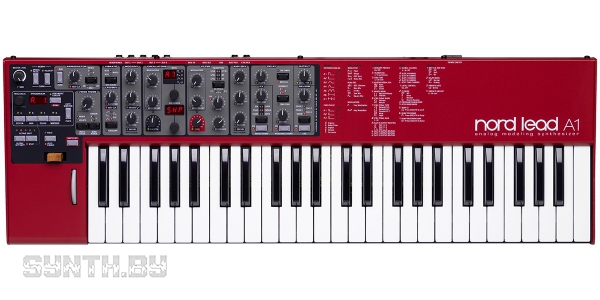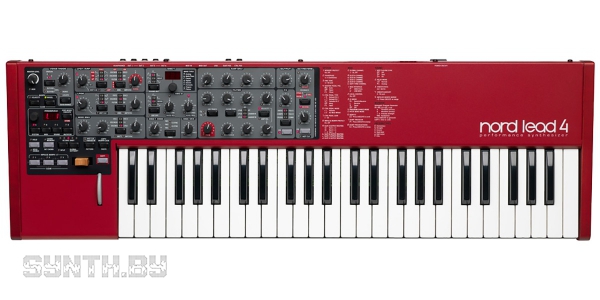Nord Lead A1 came out right after Nord Lead 4. They look alike though not completely – A1 has a little bit more compact dimensions. Both keyboards have 49 notes, are velocity sensitive, retain Clavia classic mod wheel and wooden pitch bend lever as well as a 4-part multitimbrality traditional for Lead series. A1 and Lead 4 offer the same memory, MIDI and USB integration, support Nord Sound Manager but A1 gives 6 more voices of the polyphony though there are fewer controllers.
Let’s suppose Nord Lead A1 is a happy medium between Nord Lead 4 and Stage series. Its concept inspires, helps you to experiment and allows to get to the sounds which were hidden in the structural jungle of previous Nords, moreover its quality is definitely as good. Despite the fact that Lead A1 has a lower cost than Lead 4 does it’s definitely not a budget instrument and its price tag is considerably higher than that of Roland Gaia or KingKORG.
The developer of Nord Lead A1 points out that he kept in mind a certain idea when he reduced the number of panel controlls. He was going to construct a quick-thinking machine with basic functionality but ample sound space. By “sound space” he means operation with the actual sound – more like playing with it and enjoying the process instead of plunging into the programming only to find yourself clambering hell out of it. Clavia went against market requirements but they assure us that the limits is exactly what we need sometimes.
A1 is not as flexible as Lead 4 but the effects have been improved and pads editing has become much smoother and much more prompt, almost perfect. Clavia convinced us that they had no intention to turn A1 into a stripped-down Lead 4 version while lowering the cost as well as they didn’t try to deprive their new virtual analog synth of those functions we’ve already liked so much. Clavia sees A1 as an affordable product but even though adds new amusing sonic nuances.
The key goal was to recreate that analog signal charm you get with real voltage control and we can claim that Nord Lead A1 achieved this peculiar quiver: soft versatile sound and reverbs successfully imitating analog originals.
Lead 4 offers one ADSR envelope per amp and filter while A1 splits it in two making up ADR+ASR – a good move though quite a difference. But let’s mention such strong points of A1 synthesis as increased polyphony, simultaneous delay and reverb as well as chorus, ensemble and flanger.
Besides the traditional set of analog waveforms Nord Lead A1 features extended analog ones, fixed pulse waves (since PWM is not available), bell and tine sounds, single-cycle digital waves, a few EP and Clavinets. As a bonus there is a selection of nine popular drawbar organ setting options.
Nord Lead 4 had a range of great sounding filters including Minimoog and Roland TB emulations. Although A1 is no way worse here and makes Clavia proud of its filter section which seems to deliver all the details of that grainy vintage feel.
A1 has a “Like” button which comes in handy for sure – it captures any running setting allowing to store up to 50 temporary edits. Later you can scroll through the “Like” buffer and save all the results you’re satisfied with which is a really nice feature as we know what an elusive process sound programming is.
In Performance mode Nord A1 provides 4 simultaneous programs paying respect to keyboard splits and layers. Such function as Multi-Focus gives an opportunity to change parameters of all the programs at once in Performance mode. Thus with Multi-Focus you can control, for example, the attack stage of all the 4 parts of a layer which is truly helpful during live performing. Mutator function creates a new program automatically and accordingly with the current settings, while Randomize will write a program based on random ones.
Besides some of those disadvantages we’ve already mentioned above we should also note the lack of aftertouch and audio input (wich Lead 4 actually lacks too). Anyway A1 gives that familiar Nord sound and filter emulations at a lower price, well, it also supplies a 26-voice polyphony, more simultaneous effects and draws our attention to the core concept of Nord Lead A1 – its urgent system response and access to that ample sound space provided with unique “Like” function and Oscillator Configuration Shortcuts which unfold sound potential of the instrument.
Clavia had no intention to clash Nord Lead A1 and Nord Lead 4 on the race track: they definitely don’t compete in subtractive synthesis. It’s just that Lead A1 features presets capable of quality copying those retro analog voices as great as the neat and trim sound of modern Lead series units.


